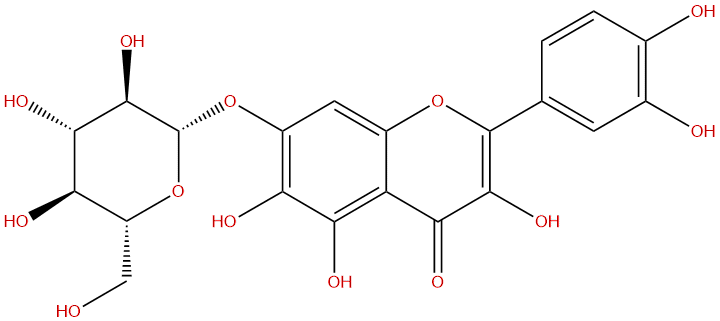
QuercetagitrinCAS No.:548-75-4
|
||||||||||
 |
|
|
||||||||

| Catalogue No.: | BP4113 |
| Formula: | C21H20O13 |
| Mol Weight: | 480.378 |
Product name: Quercetagitrin
Synonym name: Quercetagetin 7-glucoside;Quercetagetin 7-O-β-D-glucosi
Catalogue No.: BP4113
Cas No.: 548-75-4
Formula: C21H20O13
Mol Weight: 480.378
Botanical Source: Tagetes erecta L
Physical Description:
Type of Compound: Flavonoids
Purity: 95%~99%
Analysis Method: HPLC-DAD or/and HPLC-ELSD
Identification Method: Mass, NMR
Packing: Brown vial or HDPE plastic bottle
Storage: Store in a well closed container, protected from air and light. Put into refrigerate or freeze for long term storage.
The product could be supplied from milligrams to grams
Inquire for bulk scale.
For Reference Standard and R&D, Not for Human Use Directly.
Description:
Quercetagetin-7-O-glucoside, a potent inhibitor of beta-glucuronidase and lysozyme release, shows anti-inflammatory activity, can significantly inhibit arachidonic acid release from membranes.
References:
Z Naturforsch C. 1994 Mar-Apr;49(3-4):235-40.
Influence of anti-inflammatory flavonoids on degranulation and arachidonic acid release in rat neutrophils.
We assessed the effects of 24 flavonoid derivatives, reported as anti-inflammatory, on lysosomal enzyme secretion and arachidonic acid release in rat neutrophils.
METHODS AND RESULTS:
Amentoflavone, Quercetagetin-7-O-glucoside, apigenin, fisetin, kaempferol, luteolin and quercetin were the most potent inhibitors of beta-glucuronidase and lysozyme release. The first compound was also able to inhibit basal release. These flavonoids besides chrysin and to a reduced extent, naringenin, significantly inhibited arachidonic acid release from membranes.
CONCLUSIONS:
A correlation between degranulation and arachidonic acid release was found for this series of compounds. Structure-activity relationships and implications for the anti-inflammatory effects of these flavonoids were discussed.